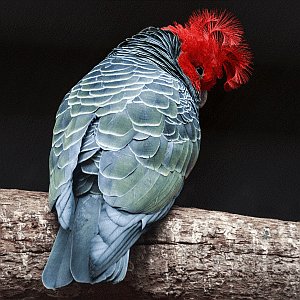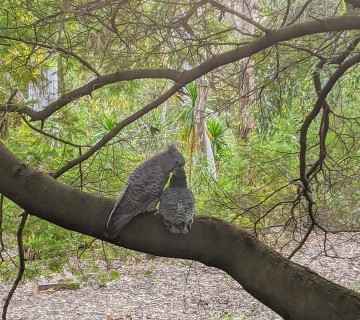Gang-Gangs in the Gardens
You are here

Several Friends have been recording observations of Gang-gangs in the Botanic Gardens for a week in February, May, August and November since 2014-15 and contributing the information as citizen scientists to research being done by the Canberra Ornithologists Group (COG).
For example, a photograph of four fledglings at the ANBG which was the first time that four fledglings had been recorded from one nesting hollow, previously the highest number on record was three.
There is increased concern about Gang-gangs, and the following is an invitation from COG to participate in recording observations of Gang-gangs in urban and non-urban environments as part of the data collection by COG and friends, and sponsored by the Federal Government. COG asks that photographs and other information be submitted to Canberra Nature Map any time you see them, as described in the email below.
However, if you would prefer to do a paper record that we can submit later on, please obtain an observation form from the Visitor Information Centre, especially between 19 to 31 November. Photos could be sent to Linda Beveridge, too, for uploading, if you wish.
We are particularly interested in observations of Gang-gangs near the Eucalypt Lawn, the Bushland Nature Track, and in areas along the trails at the top of the Gardens close to the Black Mountain Nature Reserve.
If you would like further information about Gang-gangs in the Gardens, please contact Linda by email at gkljbev1@bigpond.net.au or phone 0437 298 711.
If you would like further information about the COG research and putting records onto Canberra Nature Map, please contact Michael Mulvaney or Chris Davey as shown below.
Hi everyone,
Due to the 2019/20 bushfires there has been an increased concern about the fate of the Gang-gang Cockatoo with much of the breeding habitat affected by wild fires.
The Federal Government has provided financial assistance to help in the collection of diet and tree hollow data across the range of the Gang-gang. Continuing on from the Gang-gang survey conducted over the past couple of years in the ACT we are urging members of the public to record any indications of breeding within the ACT and local region and to record their observations on Canberra Nature Map. We are particularly interested in any recent or historical observations from rural areas including the Brindabella Ranges, Tidbinbilla, Namadgi and the Tinderry Nature Reserve.
The information we are after is directly related to increasing our knowledge on breeding events in urban and non-urban areas and in areas affected and not affected by the latest bushfires.
Gang-gangs can be found around tree hollows at any time of the year but the behaviours we are particularly interested in are as follows:
- Seen entering or leaving a hollow
- Seen looking into a hollow
- Seen perched or near a hollow
- Chewing bark around a hollow
If possible, we would like records to be submitted to Canberra Nature Map so that all observations are stored in one place. To enter observations log onto Canberra Nature Map, click on ‘Add a sighting’, add an image or click the location on the map, click on Identification- Birds- Parrots- Gang-gang and then answer the questions or provide further information. For additional information on Gang-gangs enter ‘Gang-gang’ in the ‘Quick Search’ box.
Photos are preferred but not essential with the geo-coordinates obtained by clicking the site location on the map.
Any queries please contact Michael Mulvaney (mulvaney@netspeed.com.au) or Chris Davey (chris_davey@aapt.net.au)


